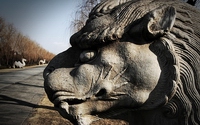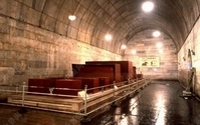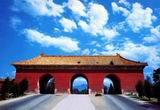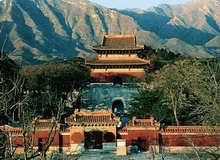
Ming Tombs
Category: World Heritage Sites
Address : Tianshou Mt. Area, Changping District, Beijing
Open Time : Daily 9:00am - 5:00pm
Reviews: ![]()
Phone : 86-10-60761424
Entrance fee: RMB60/p.p
Introduction of Ming Tombs Beijing
Many foreigners visiting the Great Wall of China at Badaling or Juyongguan will stop en route at Changping County, some fifty km northwest of Beijing, to visit the Ming Tombs. They will usually be taken directly to the Dingling, which is the resting place of one of the most insipid Chinese rulers, the Wanli Emperor. Hence, the visitors will miss the Spirit Way or Sacred Way lined by the guardian statues of 24 animals and 12 officials.
The Ming Tombs, covering a hilly area of 40 acres, was selected in 1409. In 1424 the Yongle Emperor, Zhu Di, was the first Ming Emperor to be buried here in his mausoleum called the Changling. He was the third Ming Emperor. His father and founder of the Ming Dynasty, Zhu Yuanzhang, was buried in Nanjing, and his nephew, the second Ming Emperor, from whom he usurped the throne, escaped and disappeared from official history.
All in, thirteen of sixteen Ming Emperors were buried in this royal necropolis, including Empresses and many concubines, some buried alive to accompany the Emperor to his next world. It was in the reign of the Zhengtong Emperor (1436-1449) that the practice of entombing live imperial concubines was abolished. The last Emperor to be entombed here was the Chongzhen Emperor, Zhu Youjian, in his mausoleum called Siling. This last Ming Emperor hanged himself in 1644 at Coal Hill just outside the Forbidden City when Beijing fell to the rebel army of Li Zicheng. However, the succeeding Qing (Manchu) conquerors, under Chinese imperial protocol, gave the last Ming Emperor a decent burial due to an Emperor.
Of the remaining three missing Emperors, the founder of the Ming Dynasty was buried in Nanjing, the second Emperor vanished when the Yongle Emperor usurped the throne and the seventh Ming emperor insisted on being buried in Jinshan closer to Beijing. Only three tombs are opened to the public viz Changling of the Yongle Emperor, Dingling of the Wanli Emperor and Zhaoling of the Longqing Emperor. Of these, only one tomb, the Dingling, has its tumulus (underground chamber) opened. Chinese archaeologists are excited about opening the Changling tumulus housing the powerful Yongle Emperor and possibly containing the remaining copy of the Great Dictionary of Yongle (Yongle Dadian).
The Ming Tombs follow the past traditional Chinese Imperial layout of eight components: 1. Stone Memorial Arch, the central way only for the deceased Emperor
1. Stone Memorial Arch, the central way only for the deceased Emperor
2. The Great Red Gate, where all, including the Emperor, must dismount
3. The Stele Pavilion with 7 meter high engraved stone column (huabiao)
4. The Spirit way, lined on either side by statues of animals and officers
5. The Gate of Dragon and Phoenix (Gate on the Threshold of Stars)
6. The Soul Pavilion with a marble tortoise carrying a stele on its back
7. The Tumulus or underground chamber holding the Emperor¡¯s remains
8. Sacrificial halls for sacrifices.
Dingling Tomb - The Excavated Tomb
Dingling, Tomb of Certainty, is the only Ming Tomb that has been excavated. This is the resting place of the thirteenth Ming ruler, the useless Wanli Emperor, Zhu Yijun, whose claim to fame was his long life. He left matters of state to corrupt officials and allowed the country to sink into malaise and general suffering. He ascended the throne at the age of ten years and ruled for forty eight years. When the Dingling was completed in 1581 after six years of construction and thirty-eight years before his death, he held a grand feast to celebrate his future interment.
A visitor will be surprised to see the Wanli Emperor resting with the coffins of two Empresses, one on each side. The Emperor was actually buried in 1619 with Empress Xiaoduan who preceded his death by a few months. However, his only son was by a concubine, Xiaojing, who died eight years earlier and was buried in a concubine grave. The concubine was elevated to Empress status by her grandson and thus re-buried with the Emperor Wanli.
Underground Palace of Dingling
The discovery of the entrance to the 27 meter deep underground chamber is interesting. A small tablet was unearthed in the vicinity and the Chinese characters indicated a site and a depth.

Archaeologists on following the instructions discovered a doorway to Dingling and started evacuation in 1956. Within two years the excavation was completed and the tomb was found to have jewellery and artifacts including jade belts, golden chopsticks and a crown worn by the Wanli Emperor himself. The underground chamber is made up of five marbled halls, a central hall surrounded by four other halls, the atmosphere being somewhat cold and damp.
Changling Tomb - The First Tomb
Changling, the biggest mausoleum, was built for the Yongle Emperor, Zhu Di, and took 18 years to complete. Zhu Di was the Emperor who built the Forbideen City, commissioned the Great Dictionary of Yongle (Yongle Dadian) and sent the eunuch Admiral Cheng He to South-East Asia, Ceylon, India, Africa and the Arabian Peninsula.
Changling is surrounded by sixteen satellite tombs for Zhu Di¡¯s concubines, and the tumulus has not yet been excavated. The ground structure opened to the public is a miniature Forbidden City, with an impressive Hall of Eminent Favours (LingEn Dian) of marbled floor and thirty-two sandalwood columns. The hall now serves as a museum for the precious artifacts found in the imperial coffins and twenty-three wooden chests in Dingling. The stone stele bears the inscriptions of the Ming Dynasty Renzong Emperor (Zhu Gaozhi) and Qing rulers, the Qianlong and the Jiaqing Emperors.
Beijing-Travels.com offers online information on Beijing Ming Tombs and private tours as follows, Keep browsing our site for More Attractions information in Beijing China.
Private Tours of Ming Tombs

If you could not meet a interesting tours which our predesigned with Ming Tombs, we will customize a tour to fit your exact needs.
Special Offer Travels
Beijing-Travels.com is a full service local travel agency offers popular travel packages to Beijing, Great Wall and all over of China. We specialize in "PRIVATE" & "NO-SHOPPING" tours and try to be original, unique and best to satisfy our clients, Let us assist you to experience your own vacations!


